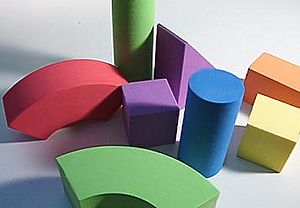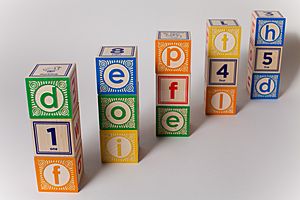Toy block facts for kids
Toy blocks are fun pieces of wood, plastic, or foam that come in many shapes, like cubes, cylinders, and arches. They also come in different colors. People use them as construction toys to build all sorts of things! Sometimes, these blocks even have letters on them, which can help you learn.
Contents
How Toy Blocks Help You Learn and Grow
Playing with toy blocks isn't just fun; it also helps you develop many important skills.
Boost Your Body Skills
When you pick up and stack blocks, you make your fingers and hands stronger. This also improves your eye-hand coordination, which is how well your eyes and hands work together. You also learn about different shapes as you play!
Grow Your Social Skills
Building with blocks often means playing with others. This helps you make friends and learn to cooperate. It's one of the first times many kids learn to share and work together. Blocks encourage you to talk and use your imagination with others, which is great for social play.
Sharpen Your Mind
As you play with blocks, you might start describing sizes, shapes, and where things are. This helps build your vocabulary. You also use math skills when you group blocks, add them together, or take them away, especially with special blocks like unit blocks. You even learn about important ideas like gravity, balance, and geometry without even realizing it!
Unleash Your Creativity
Toy blocks are perfect for letting your creative side shine. You can design and build anything you imagine, from tall towers to cool castles. There are no rules, so you can always make something new and unique.
Improve Your Language Skills
Playing regularly with blocks can help you develop better language skills. You talk about what you're building, explain your ideas, and listen to others, all of which strengthen your ability to communicate.
Different Kinds of Toy Blocks
There are many types of toy blocks, some that just stack and others that connect in clever ways.
Blocks That Just Stack
These blocks don't have special connectors; you just balance them on top of each other.
- Unit blocks are popular wooden blocks that are all made to standard sizes.
- Anchor Stone Blocks are another type of wooden block used for building.
- Kapla blocks are thin, flat wooden planks that you stack to create amazing structures.
- KEVA Planks are similar wooden planks that let you build without glue or connectors.
- Froebel Gifts are special educational materials, including wooden blocks, first used in early childhood education.
- Montessori sensorial materials also include wooden blocks designed to help children learn through their senses.
Blocks That Lock Together
Some blocks have special parts that let them connect, making your creations stronger.
Blocks with Notches
These blocks have little cuts or grooves that fit into each other.
- Lincoln Logs are toy logs with notches that let you build miniature cabins and forts.
- Stickle bricks are plastic blocks with soft, bristly parts that stick together, great for younger kids.
Blocks with Studs
These blocks have small bumps (studs) that fit into holes on other blocks, creating a strong connection.
- Kiddicraft Self-Locking Building Bricks were early plastic blocks from the 1940s and 1950s that connected in this way.
- LEGO is a very famous brand of toy interlocking plastic bricks. You can build almost anything with them!
- Lego clones are other brands that make bricks similar to Lego.
- Rasti is an Argentine toy brand that makes interlocking bricks.
- Tente is a Spanish toy brand that also makes interlocking bricks.



